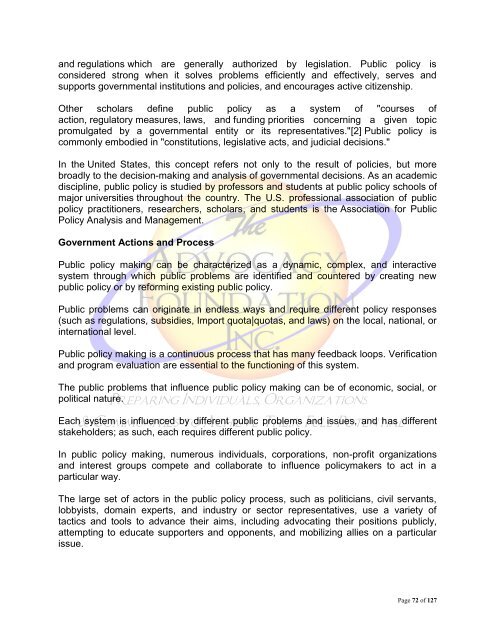Case Law, Statutory Law, Municipal Ordinances & Policy
Case Law, Statutory Law, Municipal Ordinances & Policy
Case Law, Statutory Law, Municipal Ordinances & Policy
Create successful ePaper yourself
Turn your PDF publications into a flip-book with our unique Google optimized e-Paper software.
and regulations which are generally authorized by legislation. Public policy is<br />
considered strong when it solves problems efficiently and effectively, serves and<br />
supports governmental institutions and policies, and encourages active citizenship.<br />
Other scholars define public policy as a system of "courses of<br />
action, regulatory measures, laws, and funding priorities concerning a given topic<br />
promulgated by a governmental entity or its representatives."[2] Public policy is<br />
commonly embodied in "constitutions, legislative acts, and judicial decisions."<br />
In the United States, this concept refers not only to the result of policies, but more<br />
broadly to the decision-making and analysis of governmental decisions. As an academic<br />
discipline, public policy is studied by professors and students at public policy schools of<br />
major universities throughout the country. The U.S. professional association of public<br />
policy practitioners, researchers, scholars, and students is the Association for Public<br />
<strong>Policy</strong> Analysis and Management.<br />
Government Actions and Process<br />
Public policy making can be characterized as a dynamic, complex, and interactive<br />
system through which public problems are identified and countered by creating new<br />
public policy or by reforming existing public policy.<br />
Public problems can originate in endless ways and require different policy responses<br />
(such as regulations, subsidies, Import quota|quotas, and laws) on the local, national, or<br />
international level.<br />
Public policy making is a continuous process that has many feedback loops. Verification<br />
and program evaluation are essential to the functioning of this system.<br />
The public problems that influence public policy making can be of economic, social, or<br />
political nature.<br />
Each system is influenced by different public problems and issues, and has different<br />
stakeholders; as such, each requires different public policy.<br />
In public policy making, numerous individuals, corporations, non-profit organizations<br />
and interest groups compete and collaborate to influence policymakers to act in a<br />
particular way.<br />
The large set of actors in the public policy process, such as politicians, civil servants,<br />
lobbyists, domain experts, and industry or sector representatives, use a variety of<br />
tactics and tools to advance their aims, including advocating their positions publicly,<br />
attempting to educate supporters and opponents, and mobilizing allies on a particular<br />
issue.<br />
Page 72 of 127

















